15 Nights / 16 Days
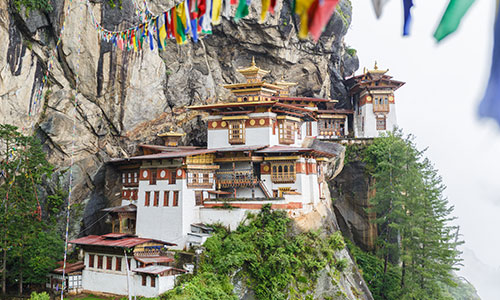
Route -
Paro - Thimphu - Punakha - Trongsa - Bumthang - Tang - Ugyenchholing - Phokphey - Ungaar - Taskila - Lhuntse- Menji - Pemi - Taupang - Trashi Yangtse - Trashigang - Mongar - Bumthang - Trongsa - Thimphu - Paro
Route Info -
Total Route Distance: 1255 kilometers approximately including hikes
Total Travel Time: 90 Hours approximately including the hikes
Trip Highlights -
Dochu La Pass - Thimphu
Druk Wangyel Chorten - Dochu La
Druk Wangyel Lhakhang - Dochu La
Punakha Dzong - Punakha
Suspension Bridge - Punakha
Thangoo Lhakhang - Wangdue Phodrang
Bajo Lhakhang - Bajo
Radak Neykhang - Wangdue Phodrang
Wangdue Phodrang Dzong Restoration Site
Pele La Pass - Wangdue Phodrang
Chendebji Chorten - Trongsa
Trongsa Dzong - Trongsa
Ta Dzong Museum - Trongsa
Yutong La Pass - Trongsa
Chumey Valley - Bumthang
Kiki La Pass - Bumthang
Jakar Dzong - Bumthang
Jambay Lhakhang - Bumthang
Chakar Lhakhang - Bumthang
Kurjey Lhakhang - Bumthang
Tamshing Lhakhang - Bumthang
Kenchosum Lhakhang - Bumthang
The Burning Lake - Tang, Bumthang
Pema Chholing Nunnery - Tang
Langmalung Lhakhang - Tang
Ugyenchholing Manor - Tang
Phokphey - Trek
Rodong La Pass - Phokphey to Ugnaar
Khini Lhakhang - Ugnaar to Takila
Guru Nangsey Zilneon Statue - Takila
Zerim La Pass - Takila to Tangmachu
Tage La Pass - Takila to Tangmachu
Lhuntse Dzong
Darchung Pang Lhakhang - Tangmachu to Menji
Dong La Pass - Pemi to Taupang
Trashi Yangtse Dzong
Chorten Kora - Trashi Yangtse
Trashigang Dzong
Thrumshing La Pass - Mongar to Ura
Ura Valley - Ura, Bumthang
Shingkhar Village - Shingkhar, Bumthang
Dechen Chholing Goemba - Shingkhar
Shertang La Pass - Ura to Bumthang
Gangtey Goemba - Phobjikha Valley
Black-Necked Crane Information Center - Phobjikha
Royal Botanical Garden - Lamperi
Simtokha Dzong - Thimphu
Buddha Dordenma - Thimphu
National Memorial Chorten - Thimphu
Arts & Craft Market - Thimphu
Tachog Lhakhang - Paro
Tiger's Nest Temple - Paro
Chele La Pass - Paro-Haa
Mount Jomolhari - Chele La Pass
Mount Jichu Drake - Chele La Pass
Best Time of the Year -
The best time to trek is in winter between October-Early November or in spring between April-Early May
With your arrival at Paro International Airport and completion of all entry formalities, we will escort you to the car. We drive you to Paro (2250 m/7382 ft) town for lunch and refreshments. If you have had it on the plane, we can begin our journey towards the Capital city, Thimphu for about an hour.
Upon reaching to the capital city, we make a right turn and drive towards Punakha for about 2 to 3 hours via Dochu La Pass (3150 m/10335 ft). Its location around 108 Druk Wangyel Chortens will provide you with stunning 360 degree panoramic view of the landscape with faraway snow-capped Himalayas. We also visit Druk Wangyal Lhakhang built by eldest Queen Mother Ashi Dorji Wangmo Wangchuck to celebrate victory of His Majesty the fourth king, Jigme Singye Wangchuck and Royal Bhutan Forces from war against Indian insurgents in 2003.
After we have coffee and snacks at a restaurant we descend through Thinleygang and Lobesa into the Punakha Valley. Keeping it light on your first day should allow you to retire peacefully in the warmer and beautiful valley of Punakha and prepare for a wonderful drive ahead.
In Punakha (1310 m/4298 ft) we first visit Punakha Dzong located at the confluence of two rivers of Punatsang Chhu. We cross the Bazam Bridge which was rebuilt in 2008 after the original 17th century bridge was washed away in 1958 flood. The dzong was built by Zhabdrung Ngawang Namgyel in 1637 and was the second dzong to be built in Bhutan that it is arguably the most beautiful dzong in the country.
We exist the Dzong and we head towards a Suspension bridge across the Pho Chhu where our ride will wait for us. It is perfect visit for those who want to experience some thrilling heart pumping experience while crossing it. From here we drive on a feeder road towards Wangdue Phodrang town. You will enjoy retrospective beautiful views of villages and Punatsang Chhu. After about half an hour we arrive at Thangoo where we will visit Thangoo Lhakhang.
Further into Bajo town, we will stop at Bajo Lhakhang and explore its small town located beside the river. Driving up hill for few minutes we will visit Radak Neykhang and the restoration site of the New Dzong. Wangdue Phodrang Dzong which was about 374 years old was tragically burnt to ground on 24th June 2012 and ever since its reconstruction work has began and it is expected to complete by 2021.
We then drive uphill to Pele La Pass (3420 m/11220 ft) for about 2 to 3 hours. It is one of the most beautiful drive east offering accesses to central Bhutan over the Black Mountains, the physical boundary between western and central Bhutan. On a clear day you can try to spot Mt. Jomolhari (7326 m/24035 ft), Mt. Jichu Drake (6989 m/22930 ft) and Mt. Kang Bum (6526 m/21411 ft) towards the west marking the border of Black Mountain National Park.
Continuing towards Trongsa (2200 m/7218 ft) for about 2 hours on a declining elevation, we can spot yaks grazing on the barren hills as we manoeuver into the broad heavily cultivated Mangde Chhu Valley. Chendebji Chorten is a patterned on Kathmandu's Swaymbhunath Stupa with eyes painted at four cardinal points and we stop here on our en route to Trongsa. It was built in 18th century by Lama Ngesup Tshering Wangchuk to cover the remains of a subdued evil spirit which used to manifest in a form of a gigantic snake.
Once at Trongsa, we will stop for lunch and then explore the Trongsa Dzong. The dzong is located on a slopes of the spur attracting all the attention to itself and can been seen from as far as Tsangkha, a village right across the ravine below, before reaching Trongsa that we just biked through. It was first founded in 1543 by a Tibetan Drukpa Lama and then the Trongsa Penlop and future 3rd Desi constructed the dzong in the same spot in 1647 following instructions from Zhabdrung Ngawang Namgyal (1594-1651).
Up next, we walk up to the Ta Dzong located strategically above the Trongsa Dzong on the left bank of the Mangde Chhu. It is a massive circular five-storyed tower flanked by two lower towers built in 1652 by then first governor of Trongsa, Choeje Minjur Tenpa. The museum was opened in 2008 to commemorate three auspicious occasions: 100 years of Monarchy under Wangchuck Dynasty, enthronement of the fifth and current king and introduction of democracy in the country.
The journey to Bumthang should take us about 2 to 3 hours as we drive through Yutong La Pass (3425 m/11237 ft) and cheerful Chume Valley. Later we cross Kiki La Pass (2900 m/9514 ft) before entering into the Jakar or Bumthang Valley (2800 m/9186 ft). On arrival we check into the hotel and rejuvenate from the day's excursion.
Bumthang (2800 m/9186 ft) is often compared as 'Switzerland of Asia'. We drive uphill where the majestic Jakar Dzong stands overlooking the valley. It means "Castle of the White Bird", the Jakar Dzong constructed in 1549 by Lam Nagi Wangchuk exhibits a stunning bird-eye view of the entire valley.
We descend and drive towards the famous Kurjey Lhakhang located at about 5 kilometers away taking us roughly 10 minutes. But we will stop at iconic famous temples along the way with Jambay Lhakhang first. It was built during the 7th century by a Tibetan King named Songtsen Gampo making it one of the 108 monasteries he built to subdue evil spirits in the Himalayan region. During its festival Drup/grup from 15th to 19th of the 9th Bhutanese month, thousands of people from near and far including tourists join to watch various religious dances and enjoy the fair.
A little further is the Chakar Lhakhang, palace of the Indian King Sendha Gyab or Sindhu Raja, overlooking the river and close to the royal guest-house. The original palace was built of iron and hence the name Chakar meaning iron castle. The current building was built by a saint Dorji Lingpa during the 14th century and may sometimes be mistaken for a house but is worth a short visit.
From Chakhar Lhakhang are the famous three Kurjey Lhakhangs each built during a separate timeline. The first temple is known as Guru Lhakhang and is the oldest one built by Minjur Tenpa, then Trongsa Penlop in the year 1652, second temple is built by first King, Sir Ugyen Wangchuck in the year 1900 who was then the Trongsa Penlop and the final temple the Ka Gon Phur sum lhakhang, was built in 1984 by Ashi Kesang Choden Wangchuck Queen Grandmother of Bhutan under the guidance of Dilgo Khyentse Rinpoche along with 108 chortens around the whole complex.
We walk into a small footpath for few minutes from the nearest road point to cross a suspension bridge before visiting the Tamshing Lhakhang located across the river built by Pema Lingpa the famous treasure finder in 1501. We continue for about 2 minutes is where we will make our stop at Kenchosum Lhakhang, also believed to be built by the famous Terton Pema Lingpa around 8th century. It contained a large bell which when rung was heard all the way from Lhasa in Tibet but was dropped and cracked by Tibetan Army when they tried to steal it in the 17th century.
Driving via the Bathpalathang domestic airport we can enjoy the retrospective aspect of the valley as we ride into the Jakar town for early morning snacks. With a packed lunch and first aid medical service in the car team, they follow us as we ride towards the famous Burning Lake - Mebar Tsho located along the way to the Tang village over the feeder road. Even at present this small fresh water lake is a very sacred pilgrimage site where people offer butter lamps and prayer flags on auspicious days making it spectacular landscape with rich history for tourists to visit.
We then drive on a feeder road to Tang valley taking us about 2 hours or less depending on the condition of the road. Pema Choling Nunnery located on a windy plateau at the entrance of Tang valley, about 5 kilometers from the main Jakar-Ura-Mongar highway is where we stop for a picnic lunch. It is a monastic school (shedra) under the purview of the present Gangtey Tulku. It houses about 100 nuns between 12 and 70 year of age, who follow the Nyingma Peling tradition with 9 academic years.
Once at Tang valley, we explore the beautiful valley visiting some of its temples like Langmalung Lhakhang located at 10 minutes walk from end of the feeder road up north. We then begin our trek by hiking for about 30 minutes to Ugyenchholing Manor located above the village on a hillock. We can either spend the night in the guest house or camp in the courtyard at 2850 meters of elevation.
We begin our hike from Ugyenchholing to Phokphey after breakfast. It is about 17 kilometers away taking us about 5 to 6 hours to complete. The trail takes us through beautiful bamboos, hemlock and alpine forests. We stop along the way for picnic lunch at a spot where you can cherish and capture stunning landscapes on camera. We camp overnight at an altitude of about 3600 meters or 11811 feet.
On the third day of the trek, we hike from Phokphey to Ugnaar. We cover about 20 kilometers in about 7 to 8 hours. We make about 480 meters of ascend and 1,160 meters of descend along the trail.
We hike for about an hour to get to Rodong La Pass (4160 m/15125 ft). From here we continue to descend downhill through rhododendron, broad-leaf and conifer forests. We can also find dwarf bamboo, ferns and some tropical species until we arrive in the village of Ungaar.
The region is rich in folk stories of spirits and yetis. If the descent made your legs weary, we can camp near a ruined stone building that was used as a store house during the times of the first and second kings at an elevation of 2950 meters. If you can still continue, we head to the head of the valley below and camp overnight near Ungaar at 1770 meters.
The trail winds from Ungaar to Takila in Lhuntse district at 20 kilometers. We can successfully complete the trek in about 7 to 8 hours. It takes us about 350 meters of ascend and 1340 meters of descend.
We hike through chir-pine forests across open hills covered in lemon grass. Along the way we pass various villages such as Bulay, Kulaypang and Gomda before bringing us to Drula and Khini Lhakhang. Khini Lhakhang is one of the oldest temples in the country, built in the mid 7th century by the King Songtshen Gampo of Tibet to subdue demons in the area.
The main protective deity of the temple is a ferocious god called Taxan, depicted on a horseback. A two day festival is celebrated here in mid-November every year. From here we make a gentle descent for 2 to 3 hours before the village of Takila. We camp overnight at an elevation of about 1800 meters.
Before we continue our hiking for the day, we can visit the 173 feet high Guru Nangsey Zilneon statue, one of the tallest statues in the world. Seated on a 38 feet lotus located on a hill in Takila overlooking Tangmachu village in Menbi gewog, the construction took more than seven years.From village of Takila we hike for about 5 to 6 hours before we arrive at Tangmachu village covering a distance of about 20 kilometers. Along the trail we make 520 meters of ascend and 810 meters of descend.
We begin hiking down to a stream and back up to a basic health unit and a community school in Gorsam. Further on, we pass a Tibetan-style Umling Mani built by a lama from Tibet and a chorten on Zerim La Pass (1940 m/6365 ft). We arrive to Menjabi village of beautiful houses and terraced fields scattered across the gentle slopes of the hills.
After passing the village of Menjabi, we climb up to Tage La Pass at an elevation of 1760 meters. From here it is all downhill descend until we arrive at the village of Tangmachu (2200 m/7218 ft) near a major rice growing area in the region. You will find a beautiful School located in the village.
Our campsite is located down the hill near the side of the Kuri Chhu River beside the School. If there is a plenty of energy and daylight left, we can organize a trip to Lhuntse and visit Lhuntse Dzong. It is considered to be one of the most impressive dzongs in the country.
We leave beautiful village of Tangmachu and hike towards Menji village today. The total distance of the trail is about 16 kilometers and we can complete it in 4 to 5 hours. The trail is about 690 meters of ascend and 620 meters of descend.
The route takes us down to the river before we cross the Kuri Zampa. It then gradually winds up through paddy fields and into the village of Menji. We camp for the night above the village beside Darchu Pang Lhakhang at an altitude of 1830 meters.
The trail from Menji village to Pemi is about 20 kilometers long. We can fairly complete it within 6 to 7 hours. It consist of about 620 meters of ascend before camping at 2400 meters.
We begin hiking uphill on a steep and rough route passing through a thick forest overlooking spectacular mountains. After couple of hours we arrive onto a ridge-top meadow only to take us back into the forest again. Finally we walk through some herders huts at Pemi in a narrow ridge-top clearing from there is a view of a forested gorge and mountains beyond.
You may find out that other than the huts, there is no sign of habitation although the villagers use this area as a summer pasture. We camp overnight under in the woods.
Hiking from Pemi to Taupang is about 21 kilometers away. It should take us about 6 to 7 hours to complete. We make about 1450 meters of ascend and 1450 meters of descend.
After climbing up to Dong La Pass (3900 m/12795 ft) we rest for lunch and enjoy s splendid view of the surrounding snow-capped mountains. We then descend through a thick evergreen forest to Taupang. We camp here for the night at 2450 meters.
Today is our last day of the Rodong La Pass trek. We hike from Taupang into most eastern district of Trashi Yangtse. It is about 24 kilometers long taking us about 8 to 9 hours to complete with 720 meters of ascends.
It is the longest day of the trek with a gradual descent to Trashi Yangtse. We hike downhill through Chir-pine and hardwood forest of oak. We camp overnight at 1700 meters of elevation.
After breakfast we visit the Trashi Yangtse dzong, one of the oldest dzong in Bhutan dating back to 9th century. It means 'Fortress of Auspicious Fortune' was rebuilt in 1656 by Terton Pema Lingpa from the ruins of Dongdi Dzong. It was further renovated and sanctified by a sacred consecration ceremony in 2005.
We then drive towards Trashigang for about 2 to 3 hours. We visit Chorten Kora on our way and then Trashigang Dzong covering about 54 kilometers. Continuing drive towards West, we drive for about 2 to 3 hours before we stop at Mongar town for lunch.
We then enjoy a relaxed drive over Thrumshing La Pass (3780 m/12402 ft) and birding paradise of Bhutan (Sengor, Yongkala Pass, Namling and Limithang) for about 3 to 4 hours towards beautiful Ura valley (3000 m/9843 ft). We enjoy the stunning view of the village and if you happened to visit during late spring you may be lucky to witness the annual Ura festival.
You can also visit Shingkhar village at an elevation of 3400 meters where Dechen Chholing Goemba's majestic surrounding is a perfect place relax. We spend overnight at a hotel or camp in the beautiful Ura valley.
We leave Ura valley driving over Shertang La Pass at 3600 meters above sea level. It will offer you with magnificent views of Mt. Gangkar Puensum on clear sunny days, the highest unclimbed mountain in Bhutan. After driving for 2 hours we cover about 64 kilometers to arrive at Bumthang.
After exploring Bumthang town we drive for another 2 hours via Chume Valley and Yutong La Pass towards Trongsa. We make a brief stop in Trongsa for lunch and then drive straight to Phobjikha, the Black -necked Crane valley.
Gangtey Goemba (2900 m or 9514 ft) of Phobjikha is our first stop located on a forested hill overlooking the entire green expanse of the valley. It was built by Pema Thinley, the grandson and reincarnation of Pema Lingpa in 1613 and the larger Goemba was built by the second reincarnation, Tenzing Legpey Dhendup.
By stopping at the Black-Necked Crane Information Center of Royal Society for Protection of Nature (RSPN), you can get a better insight into the valley's treasure. From spotting the cranes (during season) through powerful spotting scopes, checking the information inventory to biking around the feeder road you can choose activity to expedite for the rest of the day. We can also either opt out to experience a Bhutanese Home-stay or regular hotel for the night.
Leaving behind beautiful Phobjikha valley we drive west towards the capital city, Thimphu. We drive through warmer valley of Wangdue Phodrang for about 3 hours.
Before climbing up the Dochu La hilly highway, we will stop to visit the Royal Botanical Garden located in the heart of Lamperi which homes about 46 species of Rhododendrons, 115 species of ferns, 46 species of avifauna and a popular birding destination. You can try peddling a boat across the Lamperi Lake and try to identify various flora and fauna species as you come across them.
After lunch at Dochu La Pass we continue our journey into the capital city. We will take left turn and visit Simtokha Dzong the first Dzong built by Zhabdrung Ngawang Namgyel in the year 1629. The legend has it that the site guards a demon that had vanished into the rock nearby, hence the name Simtokha, simmo: demoness and do: Stone. We stop at Dochu La Pass for lunch.
We drive to a massive Buddha Shakyamuni statue; Buddha Dordenma grabs your attention from a hilltop of Kuenselphodrang. It stands majestically at a height of 51.5 meters made of bronze and gilded in gold making it one of the largest statues of Buddha in the world. It has about 125,000 smaller Buddha statues inside.
Driving further inside the city, we stop at the National Memorial Chorten a focus of daily worship for many elderly Bhutanese and others alike, which is visible majestically from the Buddha Dordenma hilly driveway. It was built in 1974 as a memorial to the third King, Jigme Dorji Wangchuck father of modern Bhutan and world peace.
Later in the evening we can go out for a leisure stroll into the town to experience the Bhutanese Capital city buzz. You can visit the Arts and Crafts Market to buy some trip souvenir. We retire for the night at the hotel after visiting a sauna to rejuvenate from your journey.
After ample amount of time for you to acclimatize to Bhutanese altitudes and atmosphere on your last day, we hike up the strenuous Tiger's Nest temple trial. No visit to Bhutan is considered complete without a visit to this most iconic landmark and religious site. It was first built in 1692 by Gyalsey Tenzin Rabgye at a cave where Guru Rinpoche meditated in the 7th century clinging impossibly to a sheer cliff of about 900 meters above the Paro Valley.
We drive for about an hour and half from Thimphu stopping at Tachog Lhakhang along the way. From the base of the hike route we start climbing uphill through beautiful pine forests gentle and wide at first. We ascend for about 2 hours to get to the resting stop from where we can witness a spectacular view of the Taktsang monastery. The total hike to and from Taktsang monastery takes about 4 to 6 hours depending upon how well you can hike and for those who are not able to climb, we can hire horses to aid you.
If you prefer to dine at this iconic landscape we can stop on our way back from the monastery for lunch and refreshments at the Taktsang Cafeteria. Or else if you prefer to hike down with lighter stomach, we will continue our journey to the base and head to the hotel.
As we near late afternoon if you have ample amount of energy left, we will drive for an hour to Chele La Pass at 3,988 meters being one of the highest motor-able passes in Bhutan. We drive through a thick forested road of a botanical paradise and once we get on the top it provides stunning panoramic views of sacred mountain Mt. Jomolhari and Mt. Jichu Drake. Wild roses, purple and yellow primulas and blue iris cover the ground along with various species of rhododendrons.
If you like birding, here at the pass we could try to spot three different species of pheasants such as Himalayan Monal, flocks of Blood Pheasants and Kalij Pheasant. We may also find several rosefinches, grosbeaks and laughingthrushes. Driving back to Paro, we retire for the night at the hotel.
Before your flight, we share a hearty conversation over a breakfast. Your comments and suggestions about your time with us will be highly valued to improve our services. Our friendship do not end today with your departure, rather continues with hopes to see you again at another time.
We are a family based company and treating our clientele as one of our own family members is our main goal. By understanding our own travel experiences, we wish to make your visit interesting and meaningful. We want your travel experience to be as friendly, truthful, caring, and helpful as a family member would be with us. With these principles in our minds and hearts, the door of Acholala Effect (your home away from home) is always open to you. We want the memories you create in Bhutan to be ones you always treasure like we treasure our land, family, and culture here. Read More...

 15D/14N
15D/14N
 14D/13N
14D/13N
Journey to the Center of the Himalayas 2..
Paro - Thimphu - Punakha - Trongsa - Bumthang
 13D/12N
13D/12N
 12D/11N
12D/11N
 11D/10N
11D/10N
 10D/9N
10D/9N
 9D/8N
9D/8N
Journey to the Center of the Himalayas T..
Paro - Thimphu - Punakha - Trongsa - Bumthang
 8D/7N
8D/7N
 8D/7N
8D/7N
 16D/15N
16D/15N
New Delhi - Bikaner - Jaisalmer - Jodhpur - Ranakpur - Jaipur - Agra - Mandawa - Ti..
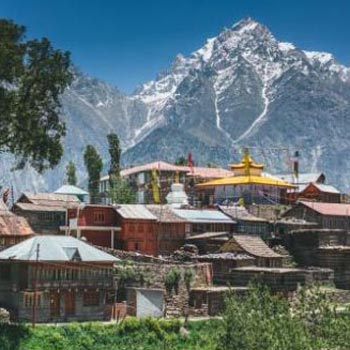 16D/15N
16D/15N
Shimla,Kinnaur,Manali,Amritsar Romantic ..
Shimla - Kinnaur - Manali - Amritsar
 16D/15N
16D/15N
Bikaner - Jodhpur - Jaisalmer - Mount Abu - Chittorgarh - Pushkar - Ajmer - Jaipur ..
 16D/15N
16D/15N
Golden Triangle with Yoga Meditation Tour
New Delhi - Agra - Jaipur - Rishikesh - Haridwar
 16D/15N
16D/15N
16 Days North & South India Tour
Agra - Jaipur - Bangalore - Periyar - Mumbai - Mahabaleshwar
 16D/15N
16D/15N
Mumbai - Goa City - Belgaum - Bagalkot - Badami - Hassan - Mysore - Bangalore - Hos..
 16D/15N
16D/15N
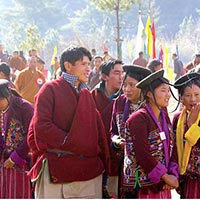 16D/15N
16D/15N
 16D/15N
16D/15N
 5D/4N
5D/4N
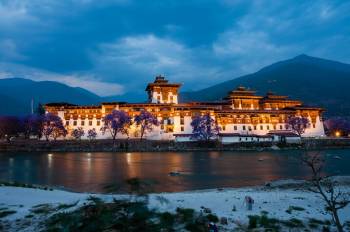 7D/6N
7D/6N
6 Nights/ 7 Days - Bhutan Happiness Tour
Punakha - Bumthang - Paro - Thimphu - Phobjik
 20D/19N
20D/19N
20 Days Land Package Country Tour BHUTAN..
Punakha - Paro - Phuntsholing - Bagdogra - Bumthang - Mongar - Trashigang - Trongsa..
 6D/5N
6D/5N
 4D/3N
4D/3N
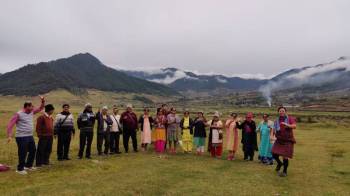 6D/5N
6D/5N
 7D/6N
7D/6N